
The Atari 2600 is a home video game console developed and produced by Atari, Inc. Released in September 1977 as the Atari Video Computer System, it popularized microprocessor-based hardware and games stored on swappable ROM cartridges, a format first used with the Fairchild Channel F in 1976. The VCS was bundled with two joystick controllers, a conjoined pair of paddle controllers, and a game cartridge—initially Combat and later Pac-Man. Sears sold the system as the Tele-Games Video Arcade. Atari rebranded the VCS as the Atari 2600 in November 1982 alongside the release of the Atari 5200.

E.T. the Extra-Terrestrial is a 1982 adventure video game developed and published by Atari, Inc. for the Atari 2600 and based on the film of the same name. The game's objective is to guide the eponymous character through various screens to collect three pieces of an interplanetary telephone that will allow him to contact his home planet.

Adventure is a video game developed by Warren Robinett for the Atari Video Computer System and released in 1980 by Atari, Inc. The player controls a square avatar whose quest is to explore an open-ended environment to find a magical chalice and return it to the golden castle. The game world is populated by roaming enemies: three dragons that can eat the avatar and a bat that randomly steals and hides items around the game world. Adventure introduced new elements to console games, including enemies that continue to move when offscreen.

Pitfall! is a video game developed by David Crane for the Atari 2600 and released in 1982 by Activision. The player controls Pitfall Harry, who has a time limit of 20 minutes to seek treasure in a jungle. The game world is populated by enemies and hazards that variously cause the player to lose lives or points.

Tempest is a 1981 arcade game by Atari Inc., designed and programmed by Dave Theurer. It takes place on a three-dimensional surface divided into lanes, sometimes as a closed tube, and viewed from one end. The player controls a claw-shaped "blaster" that sits on the edge of the surface, snapping from segment to segment as a rotary knob is turned, and can fire blaster shots to destroy enemies and obstacles by pressing a button.

Cabbage Patch Kids: Adventures in the Park is a 1984 action/platform game based on the Cabbage Patch Kids franchise. It is the first and only game in the Cabbage Patch Kids Adventures series.

Quadrun is a video game for the Atari 2600 developed by Steve Woita and published in 1983 by Atari, Inc. One of the four Atari Club games available exclusively via mail order, this title may have been available later in stores in very limited quantities. Only approximately 10,000 cartridges were initially made. Quadrun is the first Atari 2600 game with voice synthesis ; the only other is Open Sesame, made by Bit Corp.
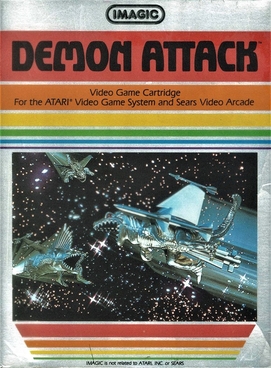
Demon Attack is a fixed shooter video game created by Rob Fulop for the Atari 2600 and published by Imagic in 1982. The game involves the player controlling a laser cannon from the surface of a planet, shooting winged demons that fly down and attack the player in different sets of patterns.

Smurf: Rescue in Gargamel's Castle is a 1982 video game published and developed by Coleco for the ColecoVision and Atari 2600. The game is based on the television series The Smurfs. In the game, the player must brave a series of obstacles to rescue Smurfette from Gargamel's castle.

H.E.R.O. is a video game designed by John Van Ryzin and published by Activision for the Atari 2600 in March 1984. It was ported to the Apple II, Atari 5200, Atari 8-bit family, ColecoVision, Commodore 64, MSX, and ZX Spectrum.

Keystone Kapers is a platform game developed by Garry Kitchen for the Atari 2600 and published by Activision in 1983. The game involves a Keystone Cops-theme, with the player controlling police officer Kelly, who traverses the many levels of a department store, dodging objects to catch the escaped thief Harry Hooligan.
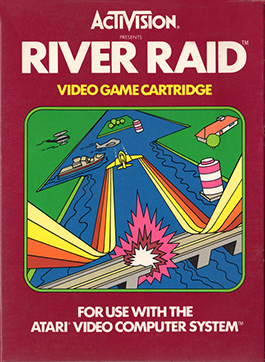
River Raid is a video game developed by Carol Shaw for the Atari Video Computer System and released in 1982 by Activision. The player controls a fighter jet over the River of No Return in a raid behind enemy lines. The goal is to navigate the flight by destroying enemy tankers, helicopters, fuel depots and bridges without running out of fuel or crashing.

Megamania is a video game developed by Steve Cartwright and published by Activision in 1982. The game is a fixed shooter, where a pilot of an intergalactic space cruiser who after eating a variety of food, has a nightmare where his ship is being attacked by food and house hold objects. Using the missile launcher from his space cruiser, he finds himself being attacked by various food items and house hold objects.
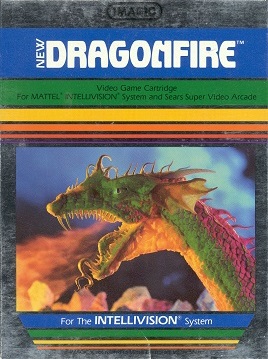
Dragonfire is a 1982 video game written by Bob Smith and published by Imagic. The player grabs treasure guarded by a dragon while avoiding fireballs. It was originally released for the Atari 2600 then ported to the Intellivision, VIC-20, Commodore 64, Apple II, ZX Spectrum, ColecoVision, and TRS-80 Color Computer.
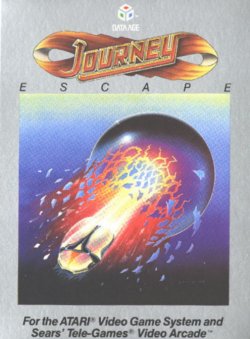
Journey Escape is a video game developed and manufactured by Data Age in San Jose, California for the Atari 2600 console, and released in 1982. It stars the rock band Journey, one of the world's most popular acts at the time, and is based on their album Escape.

Skiing is a video game cartridge for the Atari 2600. It was authored by Bob Whitehead and released by Activision in 1980. It's one of the first video games developed by Activision.

Duck Attack! is an action-adventure video game developed by Will Nicholes for the Atari 2600 console and published by AtariAge. The game was released at the July 2010 Classic Gaming Expo in Las Vegas.

Tooth Protectors is a rare video game for the Atari 2600 video game console. It was released exclusively via mail order in 1983 by American pharmaceutical and consumer goods manufacturer Johnson & Johnson.

Data Age was a California-based video game company that developed and published titles for the Atari 2600 platform in the mid-1980s. Among their more well-known titles were Journey Escape and Frankenstein's Monster, both published in 1982. The company was founded by Martin Meeker and four other designers. The employed 35 people by December 1982.
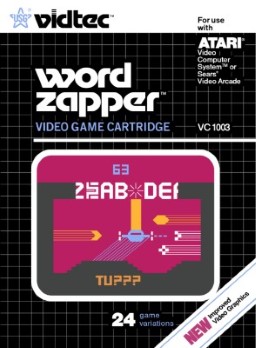
Word Zapper is an Atari 2600 game written by Henry Will IV and published under the Vidtec label of U.S. Games in 1982. Word Zapper combines spelling exercises with arcade gaming, as the player must shoot letters that scroll across the top of the screen to complete words.





















